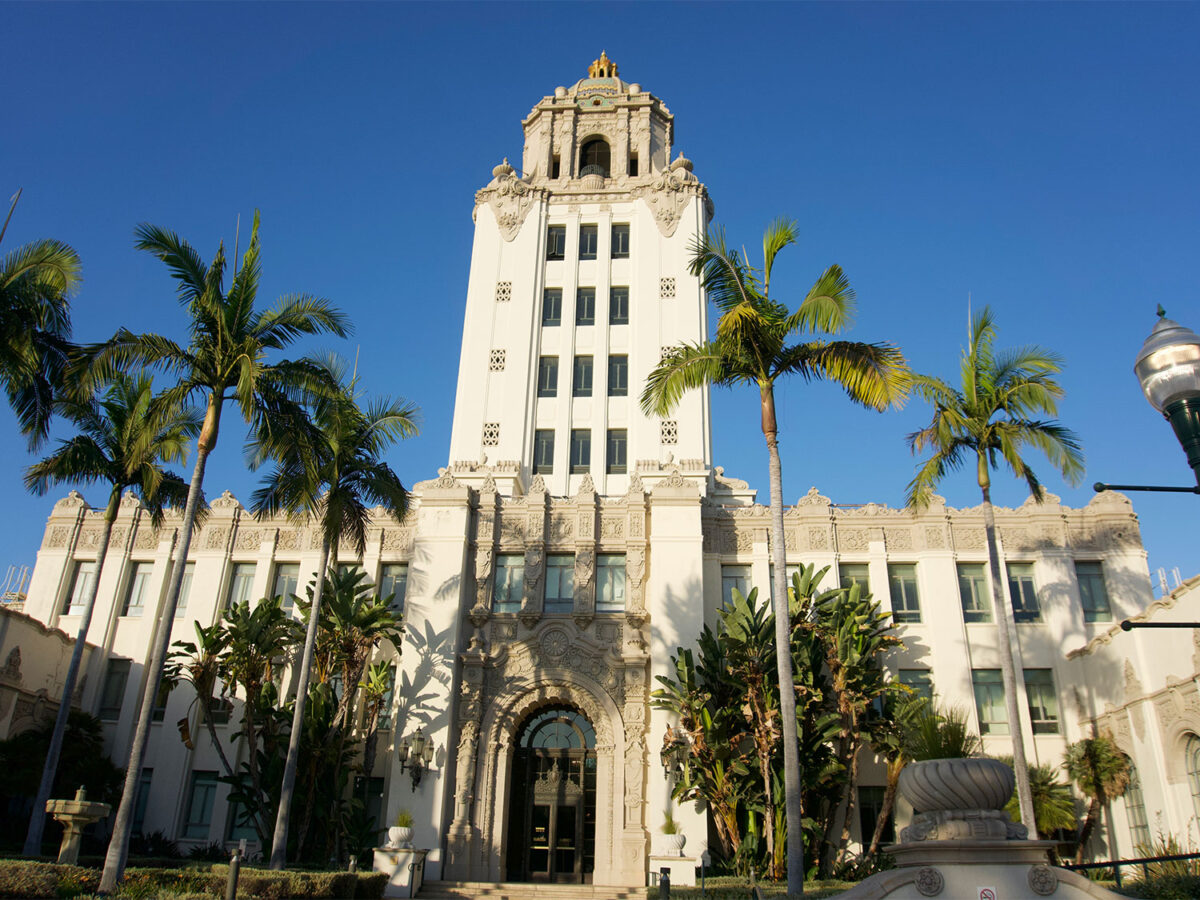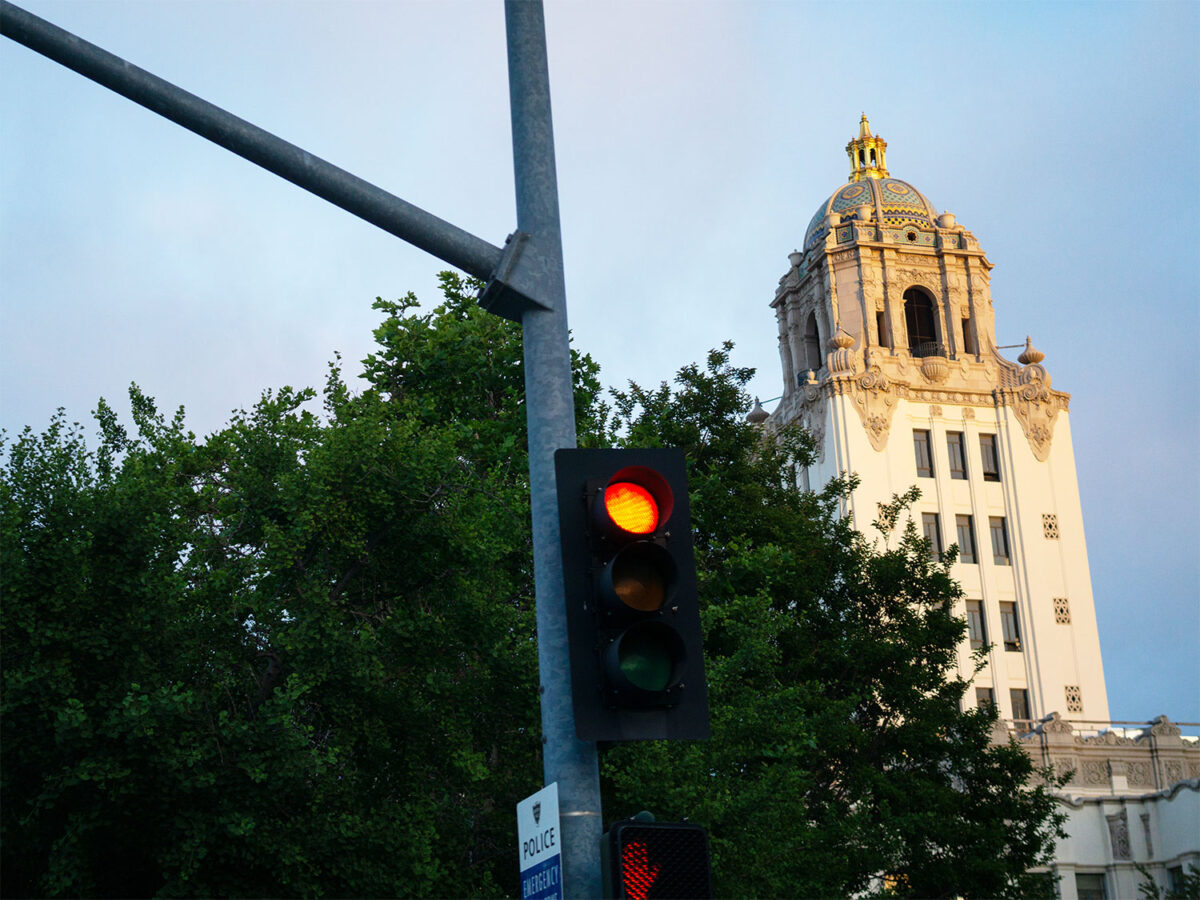The Beverly Hills City Council voted to approve the historic One Beverly Hills development in a 4-1 vote, with Councilmember John Mirisch casting the only no vote. Though the project is far from breaking ground, the vote grants the entitlements it needs to move forward.
The One Beverly Hills development is one of the largest in the city’s history–a $2 billion luxury complex including 340 residential units and 42 hotel rooms. The project site spans 17.4 contiguous acres, a feat achieved by a proposed land bridge over Merv Griffin Way that would connect the Beverly Hilton to the former Robinson-May property. This expanse includes plans for eight acres of gardens designed by local celebrated landscape architect Mark Rios, more than half of which will be open to the public. The structures and overall design come from the mind of Pritzker Prize-winning London-based Sir Norman Foster and his firm, Foster and Partners.
The developers of the project are Oasis West Realty and BH Luxury Residences, which are owned by Beny Alagem and London-based real estate firm Cain International. Alagem, who owns the Beverly Hilton and Waldorf Astoria Beverly Hills, purchased the former Robinson-May property in 2018 along with Cain for a reported $420 million.
“This has been a very long journey and the outcome is very exciting,” Alagem told the Courier. “We appreciate the hard work of the City Council, Planning Commission and staff. Their analysis and input improved One Beverly Hills. We look forward to getting started.”
The June 8 vote split along a now familiar fault line in the City Council, with echoes of the 2020 vote on the Mixed-Use Ordinance. As in that case, Mirisch argued that the city was granting overly generous terms to business interests without sufficient benefits to residents. Members of the majority of the Council offered passionate rejoinders to Mirisch’s sharp critique, defending not just the deal with the One Beverly Hills developers, but also the moral and fiscal considerations with which it was negotiated.
While much of the public comment received during the hearing reflected negative views of the project, the Council also read a letter signed by 155 businesses and residents extolling its potential benefits to the city.
“To those who don’t like this project – and we’ve heard from some – there’s not an option here of no project. The choices are clear, it’s either this project, or the previously entitled projects, which could and probably would be built,” Councilmember Julian Gold said. “And in my opinion, there’s no comparison between what could, or would, have been built and what is proposed to be built.”
Unlike the previously entitled Dalian Wanda Group project or the Hilton project, One Beverly Hills achieves the long-desired goal of connecting the Hilton and the old Robinson-May location. One Beverly Hills also includes the shuttered Union 76 Gas Station.
“This land has been vacant for 10 years,” said Vice Mayor Lili Bosse, who served on the Planning Commission at the time of the Wanda project. “When Wanda purchased it, we all wished it was a unified project and that it was one unified owner, but that wasn’t the case.” It is now.
But even while One Beverly Hills largely hewed to the entitlements for the Wanda and Hilton projects, maintaining the same square footage, the large swath of green space came at one expense: height. The prior entitlements allow for construction of buildings ranging from nine to 18 stories. The seven major structures now entitled for One Beverly Hills include a 28-story and 32-story building. If constructed, One Beverly Hills would become the tallest development in the historically low-rise city.
While some residents expressed concerns that this could set a precedent for future developments, Mayor Robert Wunderlich said that the deviation stemmed from characteristics unique to the project site.
“Compared with the other projects, it does have tall buildings, but it moves the tall buildings further to the west, immediately adjacent to Century City,” he said.
Similarly, according to Councilmember Lester Friedman, who served on the ad hoc committee that negotiated the development agreement for the city, “The manner in which the buildings are angled and the location at the extreme west end of the site mitigates bulk and mass of the project and allows for the amount of open space that has been proposed.”
Not all of the proposed features of One Beverly Hills are resolved by the Council’s June 8 vote. As a part of the conditions of approval, the Council will return to consider a proposed timeshare-style fractional ownership program once the developers flush out the plans more thoroughly. The Council will decide at that point whether or not to approve the program, which would make 37 fully furnished residential units available to owners for 30-day increments. Both Mirisch and Wunderlich expressed opposition to the program.
From its time in the Planning Commission to its final vote, the project generated the most controversy on the subject of affordable housing.
As a part of the development agreement negotiated by the city and the developers, One Beverly Hills will pay the city a $100 million public benefit fee over eight years (the Wanda project included a $60 million fee). Friedman said the payment represented the largest such fee in the state’s history.
The project will also apply a 5% municipal surcharge (essentially a higher Transient Occupancy Tax) to the new Wilshire Building luxury hotel rooms, and starting in 2030, to the Beverly Hilton. Along with that, the project would pay EMS fees to the city, which will help recoup the revenue lost in allowing residential developments on commercial sites. In the development agreement, the city will receive 2% fees on first time sales and then 3% on subsequent sales.
The $100 million clears the development of any responsibility to provide affordable housing, with advocates arguing that the sum provides more than enough to fund city-led affordable housing projects. But Mirisch was unflinching in his views on the deal. While he said the agreement had some good elements, “its complete and total fail when it comes to affordable housing is the most poisonous of pills, which makes the entire deal unacceptable and which turns a potential inclusionary project into a castle-fortress of exclusion.”
As a part of his closing remarks, Mirisch brought forward an eleventh-hour study performed by Keyser Marston Associates, who provided financial analyses for the city’s ad hoc negotiating team. The study examined the additional need for affordable housing in the region generated by the project and its resulting demand for service sector labor (the house cleaners, baristas, salespersons, and others who will serve One Beverly Hills’ wealthy residents and guests). The study found that the project would result in a need for 527 units of below market rate housing.
Mirisch’s remarks were met with an equally forceful rebuttal by Bosse, who said she was “almost speechless” following her colleague.
“There has not been anything on the table regarding affordable housing that has not been supported by our entire council,” she said.
In response to Mirisch’s questions about the pace of the entitlements process, Bosse pointed out that the City Council decided the Wanda project over three consecutive days of hearings.
“When we talk about a fiscal and moral and ethical value, I can tell you, having been on this Council now and served with everybody here, that everybody here makes all their decisions with a lens of fiscal responsibility, with a moral compass and an ethical compass,” she said.
In the midst of the contentiousness, though, the Council showed signs of possibly realizing plans for affordable housing for seniors. Earlier that day, Wunderlich invited Mirisch to serve on an ad hoc committee “with the goal of finally moving forward with a senior supportive affordable housing project I brought up over three years ago,” Mirisch said.







